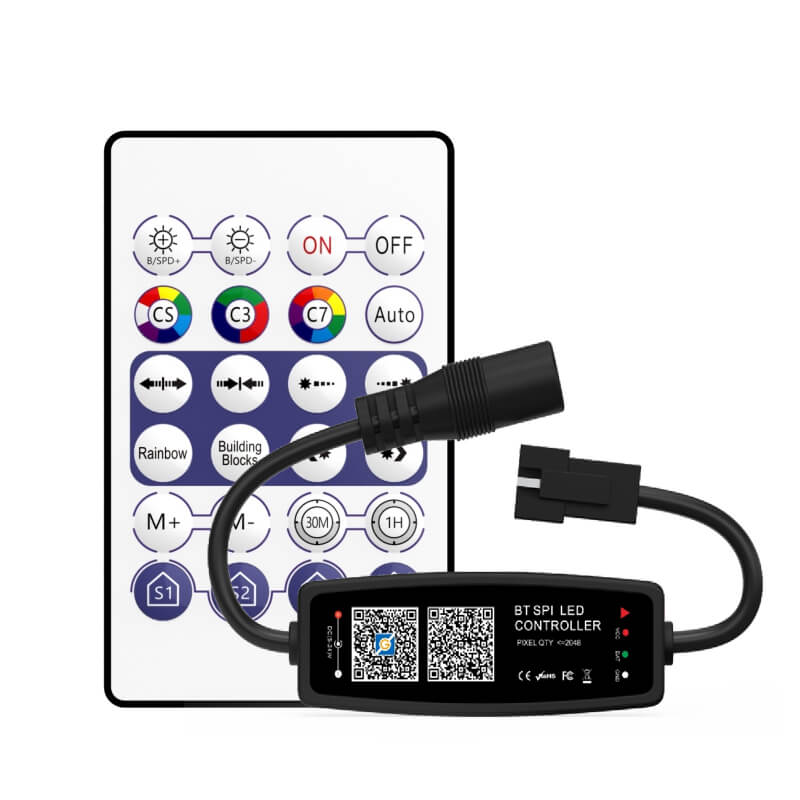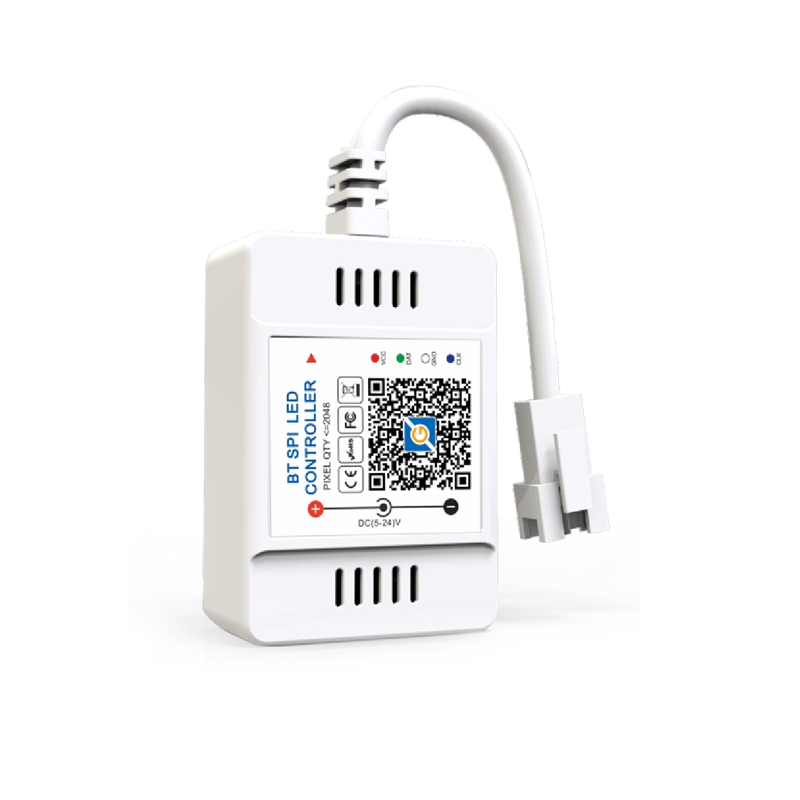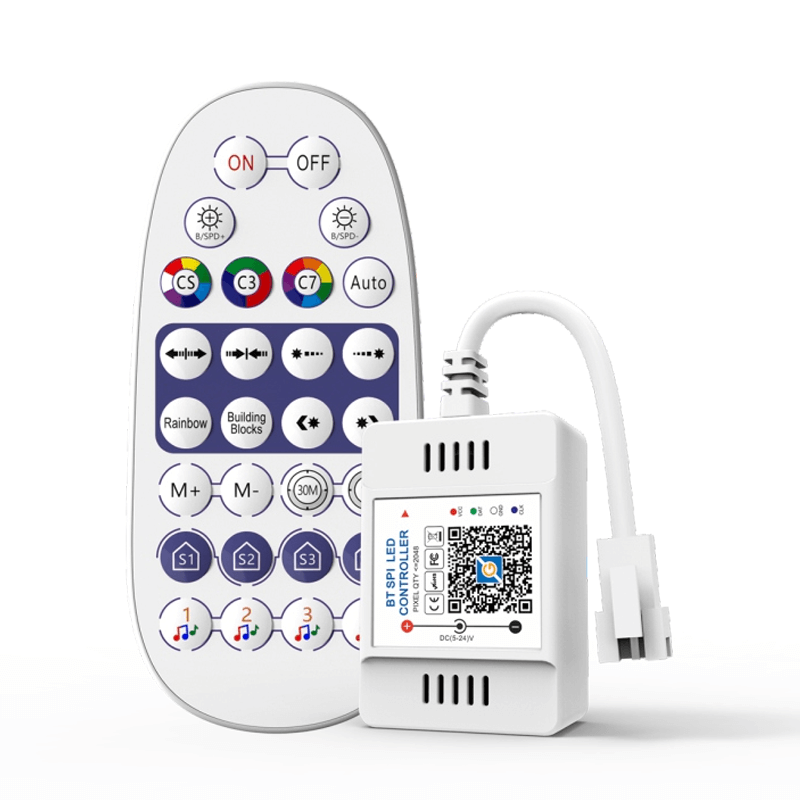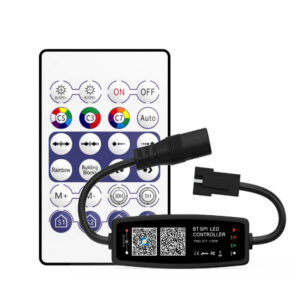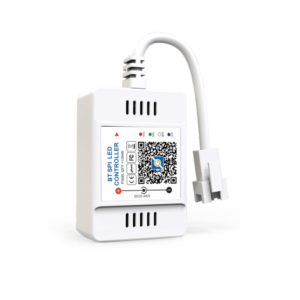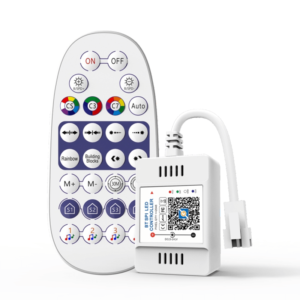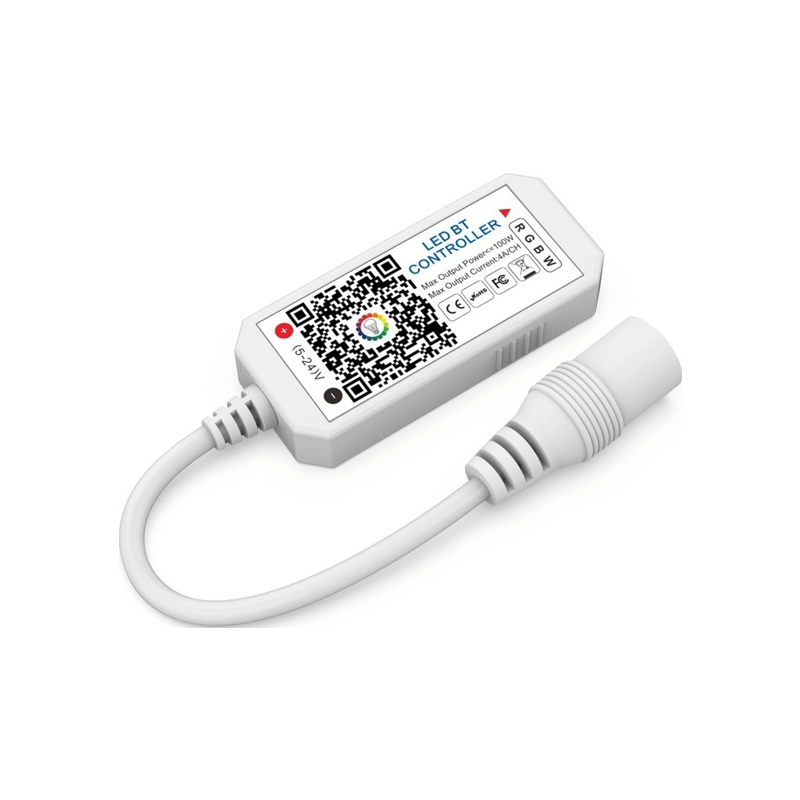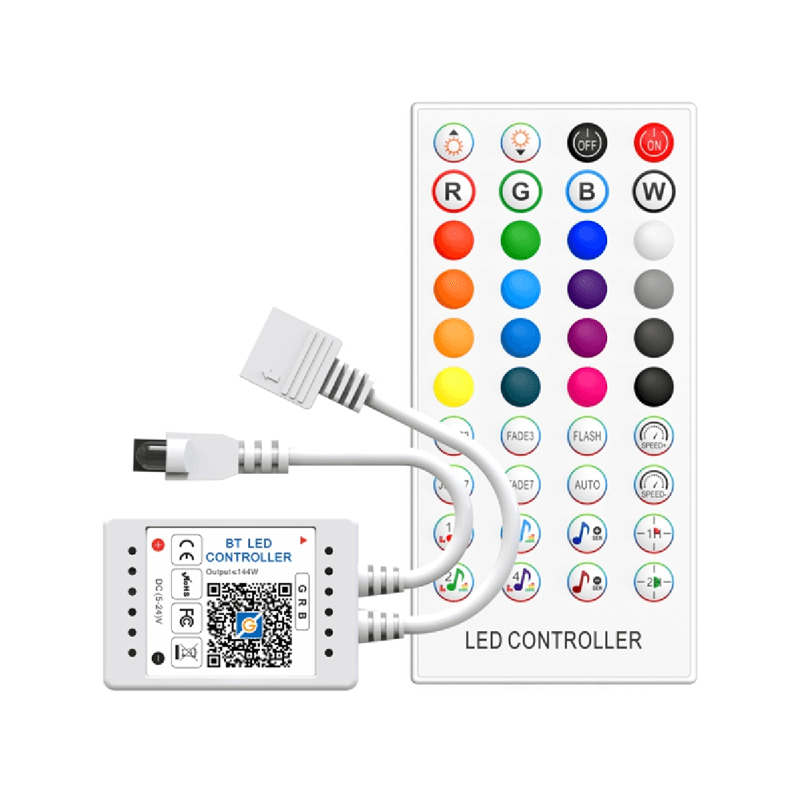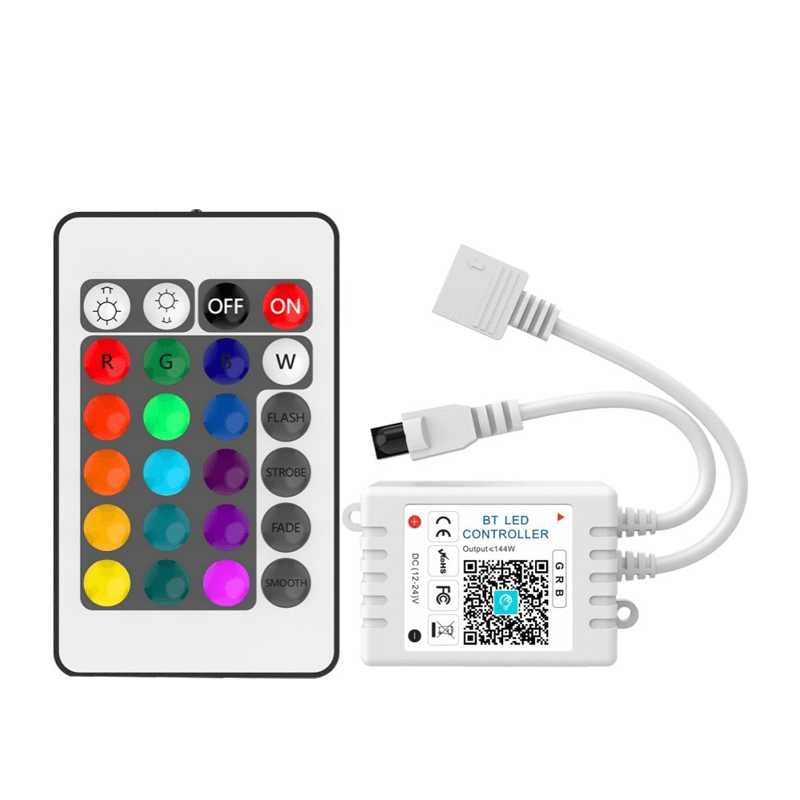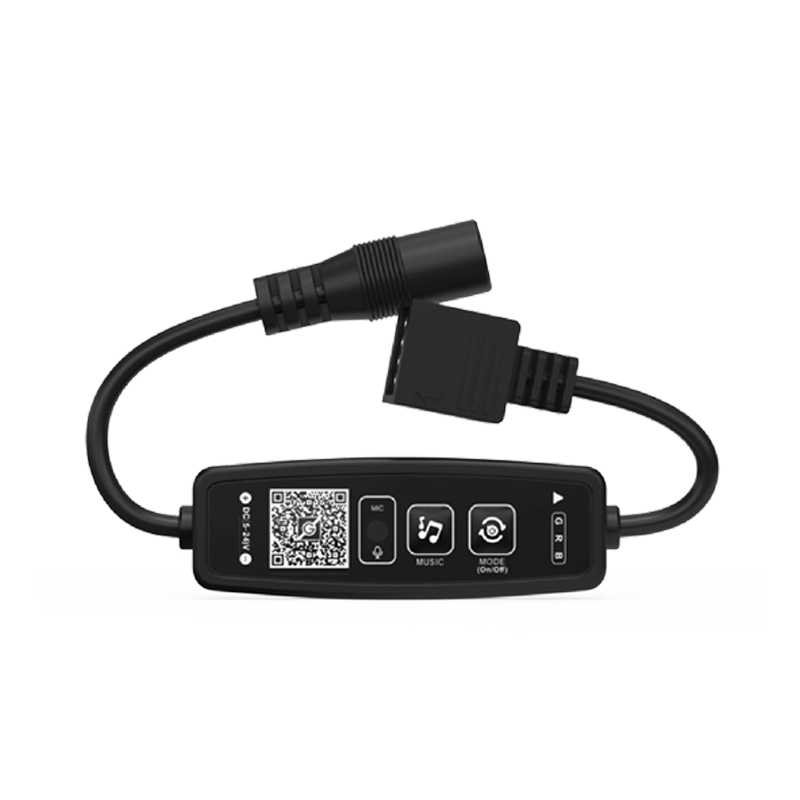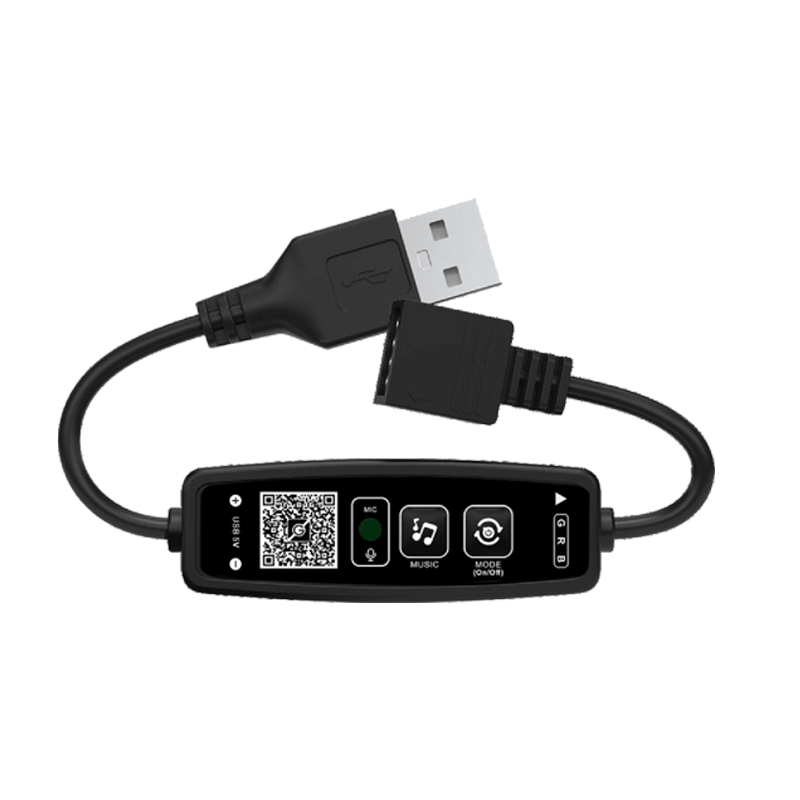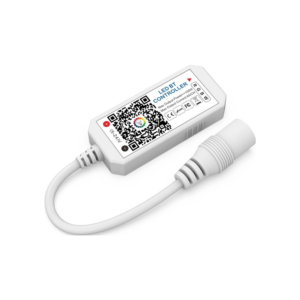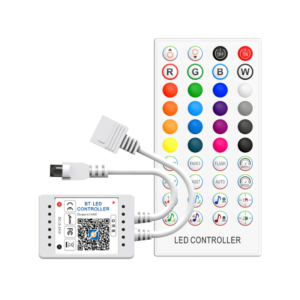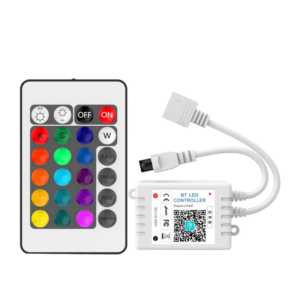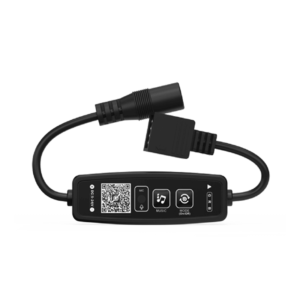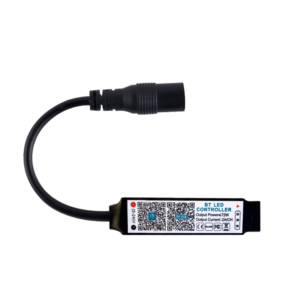
Bluetooth LED Controller Supplier & Manufacturer
One Smart Lighting is one of the leading LED controller manufacturers in China supplying Bluetooth LED Controller, WiFi LED Controller, light controllers, smart lighting switches, wireless light switches, light controllers, Christmas light controllers, LED strip controllers, LED dimmer switches.
All our Bluetooth LED controllers are CE, and RoHS certificated, ensuring high performance and a long lifetime. We offer customized solutions, OEM, and ODM services. Wholesalers, distributors, dealers, traders, and agents are welcome to purchase in bulk with us.
Magic Home Pixel Bluetooth LED Controller
Bluetooth SPI LED Controller
Volt: 5V – 24V DC
Domination Principle: Bluetooth 5.0
LED Drive Type: WS2812B,SM16703,SM16704,WS2811,UCS1903,SK6812,SK6812RGBW,INK1003,UCS2904B
Bluetooth Pixel LED Controller
Volt: 5V – 24V DC
Domination Principle: Bluetooth
LED Drive Type: WS2812B,WS2811,UCS1903,SK6812,SK6812RGBW, INK1003,UCS2904B
BT Pixel Sound-Control LED Controller
Volt: 5V – 24V DC
Domination Principle: Bluetooth
LED Drive Type: WS2812B,WS2811,UCS1903,SK6812,SK6812RGBW, INK1003,UCS2904B
Magic Home BT Pixel LED Controller
Volt: 5V – 24V DC
Domination Principle: Bluetooth
LED Drive Type: WS2812B,WS2811,UCS1903,SK6812,SK6812RGBW, INK1003,UCS2904B
Magic Home Bluetooth LED Controller
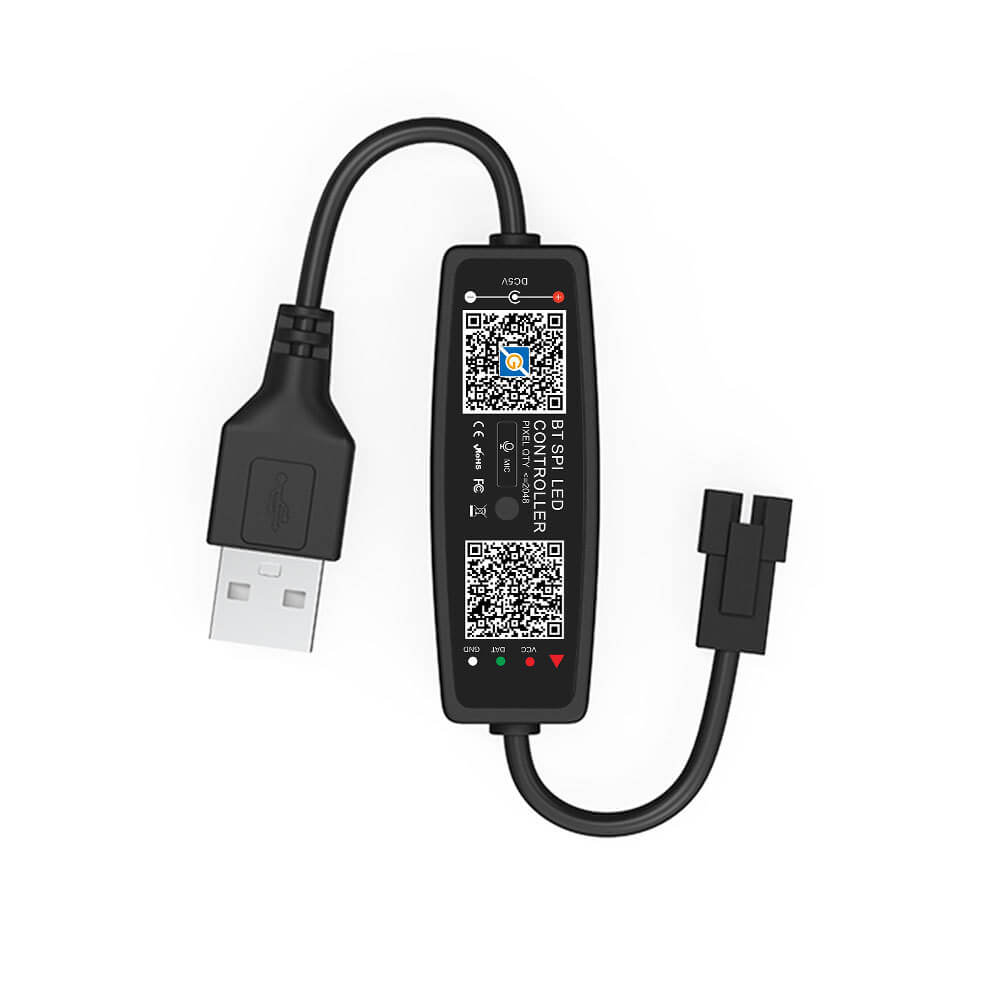
What is LED Controller?
LED controllers, also called LED strip controllers, are the necessary parts dedicated to controlling LED strip lights, Christmas lights, and other decorative lights. There are different types of LED controllers. You can use an RGB、 RGBW or RGBWW LED strip controller to change and customize the color of your LED strip lights. The LED controller is integrated with RGB management, CCT adjustment, and dimming functions, supporting 16 million kinds of color adjustment, Voice Control, Smartphone Control, and Sync Control by Group.
How does Bluetooth LED Controllers work?
Bluetooth LED controller based on Bluetooth technology with a built-in Bluetooth module that doesn’t need a network to work.
Bluetooth LED controller is connected to the LED lights. It can control the change of LED lights. It was built in Bluetooth module, using wireless communication technology, through the intelligent LED controller to transmit the signal to the smartphone. You can also access other dynamic features like custom color modes including fade jumps, and strobes syncing color changes to music, support single color, and multicolor tunable white and white with multicolor.
Why Choose Bluetooth LED Controller?
These devices are designed to control the lights with the help of an app that can easily save money. A Bluetooth LED light controller can save up to 50% of your electrical bill.
Bluetooth LED light controllers are a great addition to your home. These devices are very easy to install and set up. All you have to do is set the color of the light, turn the switch on and off, and connect it to your phone. When you want to adjust the brightness, you can use your phone or change the color on the controller. It’s a simple and easy solution for your lighting needs.
The Bluetooth light controller is the easiest to use with the least maintenance. If you want to control the light with your smartphone, you have to download the app and set up an account, which works in just a few minutes.
Bluetooth LED light controller is a device that allows you to use your smartphone as an infrared remote control for your lights. It works with Apple and Android smartphones and can control up to four sets of lights.
What is the function of a Bluetooth light controller?
- Voice Control, Compatible with Alexa, google assistant, and IFTTT
- Time switch, delay switch
APP control, you can set the groups to control the strip lights
Support 16 million kinds of color for option, DIY color selection
- Brightness adjustment
- App Built-in 20 kinds of lighting dynamic modes, can be DIY dynamic mode
- Microphone function
Sync to music: Sync light to your favorite music and enjoy every beat to the fullest
Scene color-picking function
Scene color-picking function
The advantages of Bluetooth LED controller
A Bluetooth LED controller is an electronic device that controls the brightness, color, and other settings of LED lights. It is convenient to control lights from a distance, especially in large areas.
- Bluetooth LED controllers allow for greater flexibility in lighting design. By allowing users to adjust the brightness, color, and other settings from a distance, they can create unique lighting effects that would not be possible with traditional light switches. This can be especially beneficial for businesses using LED controllers to create a unique customer atmosphere.
- LED controllers y are more energy efficient than traditional lighting systems. LED lights are much more energy efficient than their traditional counterparts, so using a Bluetooth LED controller to control the lights can help reduce energy consumption. This can help businesses save money on electricity bills and reduce their environmental impact.
- Bluetooth LED controllers are relatively inexpensive and easy to install. Most Bluetooth LED controllers are plug-and-play, which can be plugged in and used without additional wiring or installation. They are also compatible with most smartphones and other devices, allowing for easy remote control of the lights.
- Bluetooth LED controllers offer greater security than traditional lighting systems. Because they transmit data over a wireless network, they are less susceptible to hacking or other types of interference. This can help businesses protect their data and property from malicious actors.
In conclusion, Bluetooth LED controllers offer a range of benefits to businesses, including greater lighting design flexibility, energy efficiency, and increased security. They are also relatively inexpensive and easy to install, making them an attractive option for businesses looking to upgrade their lighting system.
Recommended Reading:
A Complete Guide to Bluetooth LED Controller
Difference between Bluetooth LED Controllers for 12V and 24V LED strip lights
The main difference between Bluetooth LED controllers for 12V and 24V strip lights is the voltage they can handle.12V controllers are designed to work with 12V strip lights, while 24V controllers are designed to work with 24V strip lights.
Both controllers can be used to control the brightness and color of the strip lights, but the 24V controllers are generally more powerful and can handle higher wattage loads. Additionally, some 24V controllers come with features such as dynamic color-changing and dimming capabilities.
LED Controller Bluetooth Technology
Bluetooth technology works by establishing a wireless connection between two devices. This connection is then used to transfer data between them. In the case of LED controller Bluetooth technology, the connection is used to send commands from the user’s device to the LED controller. The controller will then interpret the commands and execute them accordingly.
The range of Bluetooth-enabled LED controllers is typically around 10 meters or 30 feet. This allows users to control their lights from a distance without needing to be in the same room. This can be particularly useful for lighting up large spaces or for controlling lights in multiple rooms from a single device.
Bluetooth technology is also used in LED controllers to facilitate wireless communication between multiple users. This allows multiple users to control the lights in the same area from their own devices. For example, multiple people can adjust the brightness or color of the lights in the same room but from different devices.
The use of Bluetooth technology in LED controllers is becoming increasingly common. This is due to the ease of use and the convenience it offers. Allowing users to control their lighting from their own devices eliminates the need to make adjustments manually or physically move around to adjust the lights. Additionally, it allows multiple users to control the lights in the same space from their own devices, making it easier to coordinate different lighting effects.
Overall, LED controller Bluetooth technology is a great way to make lighting more convenient and efficient. It is becoming increasingly popular, as it allows users to control their lighting from their own devices and makes it easier to coordinate different lighting effects. Additionally, it is typically quite affordable and is becoming more widely available as its popularity increases.
Recommended Reading:
What are the key technologies affecting the future of smart homes?
Bluetooth LED Controller for LED strip lights
A Bluetooth LED controller is a device designed to implement lighting control for an LED strip, which typically consists of a small box with a Bluetooth receiver and a microcontroller that sends signals to the strip to achieve effects such as dimming, stroboscopic, and color changes.
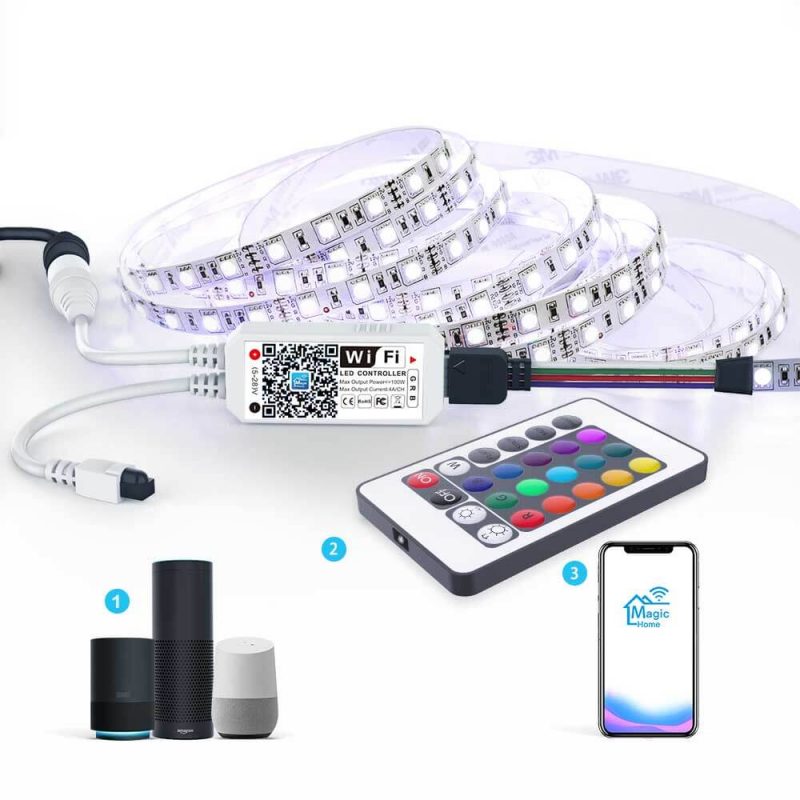
In addition, the Bluetooth LED controller is compatible with various third-party applications, allowing users to customize lighting Settings according to their preferences. To use the Bluetooth LED controller, you need to have a compatible LED light strip and a Bluetooth-enabled device, such as a smartphone, and install the APP to control the lighting effect of the LED light strip. It’s also extremely easy to use. Connect the controller to the LED light strip and use the included APP to control the lighting effects.
Bluetooth LED controller is convenient and flexible and can be used in various scenes, such as home lighting and stage lighting.
What Exactly Is an LED Controller?
In simple terms, an LED controller is a device that allows you to remotely control LED lighting in versatile ways beyond just flipping a light switch on and off. LED controllers connect to LED components like:
- LED strip lights
- LED bulbs
- LED panels or matrices
- LED fixtures
The controller provides a central hub to adjust the power, dimming, color, effects, and more of the connected LEDs through various control interfaces.
For example, an app-controlled WiFi LED controller pairs with your smartphone, allowing you to change the color of LED strips from an intuitive lighting app. Or a touchscreen LED controller offers dimming sliders and preset buttons right on the device itself.
LED controllers effectively add a “brain” to your LEDs, taking static, one-dimensional lighting and making it dynamic and customizable to your needs. The possibilities are endless!
Why LED Controllers Are a Game Changer
It’s incredible how much LED controllers can transform lighting experiences:
Wireless Convenience
LED controllers allow control from anywhere within range, without relying on wired wall switches. Adjust lighting scenes, dimness, and colors with just tap on your smartphone or smart home device.
Energy Savings
Intelligent scheduling and automation minimize unnecessary power usage. Features like dimming tailor brightness to each moment. Overall efficiency cuts lighting costs significantly.
Customization
Dial in any color or effect to match activities or moods. Programmable controllers make personalized lighting recipes and control simple.
Ambiance Enhancement
Craft beautiful, responsive lighting that complements and improves any space or activity. Dynamic lighting adds flair and life.
Advanced Integration
Link lighting seamlessly with smart speakers for voice control, home automation systems, and other devices for total environmental command.
Clearly, LED controllers unlock a world of possibilities far beyond flipping a light switch! Now let’s explore popular types of controllers available and their capabilities.
Types of LED Controllers
WiFi LED Controllers
WiFi controllers connect wirelessly to your home WiFi network, allowing lighting control through smartphone and tablet apps. This offers convenient commands from anywhere in the WiFi range. Popular for home installations.
Bluetooth LED Controllers
Bluetooth controllers create a direct wireless connection to your smartphone or tablet via Bluetooth. Does not require WiFi. Limited range but easy to use.
RF LED Controllers
RF (radio frequency) controllers use a dedicated remote to wirelessly control lighting within a short range. Low cost but less functionality than WiFi or Bluetooth options.
DMX LED Controllers
DMX controllers use the DMX512 communication standard commonly used in stage lighting. Very advanced capabilities for effects and timing. Require compatible fixtures.
Standalone LED Controllers
Self-contained controllers with built-in buttons/displays for adjusting connected lighting on the device itself. No external control is needed.
Smart LED Controllers
Offer scheduling, automation, and integration with smart home platforms and voice assistants. Allow expansive lighting automation.
RGB LED Controllers
Designed specifically for RGB color-mixing LEDs. Allow control over the red, green, and blue color channels for limitless custom shades.
Touchscreen LED Controllers
Feature an integrated touch display for intuitive control using sliders and visual selection. Convenient onboard access.
As you can see, LED controllers come in diverse varieties to suit specific lighting control needs. The right option depends on your budget, technical capabilities, and desired functionality.
Now let’s go over popular features and capabilities you gain with LED controllers.
Key Features and Functions of LED Controllers
Wireless Remote Control
The core function of LED controllers is taking lighting commands off wired switches and into convenient wireless remotes. Based on the controller type, adjust lighting from smartphones, tablets, dedicated remotes, voice assistants, and more.
Dimming
Dim LEDs up and down to precisely dial in the perfect brightness level. Much more versatile than simple on/off.
Timer/Scheduler
Automatically have lighting turn on, off, dim, or change colors on set schedules. Adds convenience and saves energy.
Color Control
Select exact colors and adjust color temperature for single-color LEDs or mix custom RGB shades. Set the ideal hue and ambiance.
Dynamic Effects
Apply flashy lighting effects like strobing, fading, and chasing lights. Great for parties and events.
Zone Control
Independently control groups of LEDs in specific zones. Allows unique lighting in different rooms or areas.
Scene/ preset Activation
Program personalized lighting recipes like “Movie Night” or “Dinner Party” and activate them on demand.
Smart Integration
Link with smart home platforms like Alexa, Google Home, or Apple HomeKit for expansive voice control and automation capabilities.
Music Visualization
Lighting reacts and syncs to music, changing dynamically based on the beat, rhythm, tempo, and sound frequencies.
As you can see, LED controllers unlock tons of possibilities far beyond basic on/off. Now let’s go over how to pick the right controller for your specific lighting needs and setup.
How to Choose the Best LED Light Controller
Here are key factors to consider when selecting an LED controller:
Lighting Compatibility
Choose a controller that works with your LED strip lights, bulbs, or fixtures. RGB, RGBW, voltage, etc.
Control Method
Decide whether a smart app, WiFi, Bluetooth, remote, or standalone control suits your needs and technical skills.
Number of Channels
Monochrome LEDs require one channel. RGB uses 3 channels. More channels allow zoned or addressable lighting.
Maximum Load
Add up the total wattage of connected LEDs and ensure the controller can handle it. Don’t overload.
Voltage Rating
Match controller voltage to LEDs – 12V, 24V, 120V, etc. Insufficient voltage prevents full brightness.
Location Rating
Indoor vs. outdoor. Outdoor requires weatherproofing and water resistance.
Special Features
Determine which advanced capabilities – dimming, color control, automation, voice activation, etc. – you want.
Prioritize features that best suit your lighting goals and budget. An outdoor area mainly needs waterproofing and scheduling. Bedroom accent lighting could benefit most from color effects and dimming. Get a sense of your must-haves and ideal specs before buying.
Now let’s walk through installing and connecting an LED controller for awesome illumination.
Step-by-Step LED Controller Installation
Installing an LED controller is much easier than traditional wired lighting. Here are the basic steps:
- Choose Install Location
Pick an indoor or outdoor location central to your LED lights within wireless range. Ensure adequate ventilation.
- Mount Controller
Securely mount the controller on a wall or other surface if not self-standing.
- Connect Power
Connect the controller power cable to outlet matching voltage requirements.
- Connect LEDs
Run connection cables from controller ports to LED strips, bulbs, or fixtures.
- Configure Settings
Power on the controller and configure wireless, zone, color, and other settings as needed.
- Pair Control Devices
Pair handheld remotes or smartphones/tablets to the controller wirelessly for control access.
And that’s it – you now have a fully functioning LED controller ready to customize your lighting! Just supply power and your controller seamlessly handles the rest.
Now let’s dive into the fun part – using your LED controller’s amazing capabilities!
Using Your LED Light Controller
The usage possibilities are endless with an LED controller, limited only by your imagination. Here are just some of the fantastic ways to use your lighting controller:
Customize Living Room Lighting
Create perfect lighting scenes for watching TV, reading, or entertaining guests with color-coded zones behind the couch, shelves, and artwork.
Automate Outdoor Lighting
Have pathway lights turn on automatically at sunset for safety and convenience. Adjust pool lighting color based on time of day.
Wake Up and Unwind with Lighting
Schedule bedroom lights to slowly brighten before wake-up time. Dim and change to peaceful colors 30 minutes before bed.
LED Accent Wall
Install an LED strip on the wall and program captivating colors, gradients, or effects like simulated candlelight flickering.
Sync Lighting to Music
Pulse and change colors in sync with songs playing through the room. Takes house parties to the next level!
LED Furniture Lighting
Illuminate customized color schemes under cabinets, beds, or shelving. Use a hidden strip with an IR extender for a clean look.
LED Gaming Immersion
Sync RGB PC case fans and components to in-game audio for explosive lighting effects.
Storefront Dynamic Lighting
Attract customers with colorful, animated windows and façade displays that stand out.
Voice-Activated Lighting
Integrate lighting with Alexa or Google Assistant for handy voice commands like “Alexa, turn the patio lights blue.”
The options are nearly endless! Use your imagination to think of creative ways to implement high-impact dynamic lighting with your LED controller.
Now let’s spotlight some inspiring LED lighting projects and applications.
Inspiring LED Lighting Projects
Here are just a few examples of the incredible lighting experiences possible when you move beyond basic illumination and leverage the power of LED controllers:
Perfectly-Timed Fireworks Show
An amusement park wanted to synchronize its nightly fireworks show to music with lights on the ground. They installed DMX LED controllers to intricately choreograph fireworks with colorful hues and explosions bursting in perfect sync with the musical score.
Sunset-Mimicking Office Lighting
An office wanted to install dynamic lighting to provide a pleasant workplace. They set up color-tunable LED panels on the ceiling that shift from cool blue midday tones to warm sunset colors in the evening to reduce eye strain and match natural circadian rhythms.
DIY LED Music Visualizer Wall
A homeowner created a stunning LED music visualizer wall using LED strip lights synced with a microphone. The lights pulse and change with music, creating an awesome display. RGB LEDs and app control allows customizing color schemes and effects.
Backyard Aurora Borealis
One creative homeowner transformed their backyard into a psychedelic display by projecting undulating shades of green, purple, and pink onto a mist screen using RGB spotlights and pixel mapping. The simulated Northern Lights effect is mesmerizing.
Pool Party Fun
Liven up your next pool party by installing colored LED pool lights synced to upbeat music playing nearby. With app control, you can change colors on demand to keep the summer celebration going in style.
Clearly, LED controllers enable lighting possibilities limited only by your creativity and imagination! Let’s now go over some key tips and considerations for getting the most out of your controller.
LED Controller Tips and Considerations
Here are some handy usage tips for your LED controller:
- Avoid Overloading– Add up total wattage and don’t exceed the controller’s max load rating. Overheating can occur.
- Minimize Static Colors– Constant full brightness strains LEDs. Use color cycling, dimming, and on/off scheduling instead.
- Keep Firmware Updated– Current firmware fixes bugs and improves performance. Update for best reliability.
- Use Light Diffusers– Softens harsh LED light for a more natural glow. Especially useful for LED strips.
- Test Day/Night Brightness– When installing, check lighting levels look good both night and day before finalizing.
- Allow Adequate Airflow– Ensure vents and fans on controllers aren’t obstructed to prevent overheating.
Take care to follow the manufacturer’s instructions and these tips to get the most out of your LED lighting controller. Proper usage and care ensure it provides amazing service for years to come!
Frequently Asked Questions About LED Controllers
Can I control any LED lights with a controller?
Most controllers are designed for either 12V or 24V LED strip lights. Some work with 12V bulbs. Only specific “Constant Voltage” controllers support 120V/240V LED fixtures. Always match voltage and wattage ratings.
Do all LED controllers allow color changing?
No, “single color” controllers only adjust brightness/power for white/yellow LEDs. For color control, choose an “RGB” or “RGBW” controller specifically designed for color-mixing LEDs.
Can I control LEDs in multiple rooms?
Yes, by running connection cables from the centrally located controller to LED strips or lights in different rooms. Just ensure total wattage doesn’t exceed the controller’s max load.
How difficult is it to program lighting effects?
Many controllers feature intuitive apps that make programming easy and fun. Effects like color loops or music sync are just the tap of a button. Some controllers do require learning more advanced lighting software.
What’s the range of wireless LED controllers?
Depends on the technology. Basic RF remotes work 10-30 feet. WiFi controls anywhere with a network signal. Bluetooth reaches 30-50 feet typically. Longer distances are possible with range extenders.
Start Enjoying Advanced LED Lighting Control
We’ve just scratched the surface of the amazing capabilities and custom lighting experiences possible with advanced LED controllers. By moving beyond basic on/off lighting, you open up a world of possibilities through color control, automation, effects, and integration limited only by your imagination.
Hopefully, this guide has illuminated how LED controllers can transform sterile lighting into a customizable centerpiece of interior design. Just picture what you could achieve in your home, workplace, or any space!
So start dreaming up your dynamic lighting vision. Browse controller options armed with knowledge of available features and how to choose the right model for your needs. Then get ready to enjoy infinite lighting experiences tailored to your activities, moods, and style!
LED Controller Manufacturer in China

